How to Declutter Your Home
Learn how to declutter your home step-by-step so you can have the tidy, organized, clutter free home you’ve been dreaming of!

We all want a decluttered home, right? We love the thought of neat and tidy, serene-feeling spaces where we can relax and actually enjoy our house rather than being constantly surrounded by clutter that stresses us out. But how do we actually make that happen?
While decluttering might seem daunting, it is actually pretty straightforward once you have a plan in place. In this post we will walk through the three key steps to creating a peaceful, decluttered home:
- Prep for your decluttering project by making a plan and gathering necessary supplies.
- Use our ORDER Method to methodically declutter each space.
- Maintain your decluttered spaces with key decluttering habits.
How to Declutter Step by Step
This post contains dozens of ideas for decluttering your home effectively. Don’t feel like you have to use all of them! Decluttering is far from one-size-fits-all. Some of these ideas may work for you and others probably won’t.
The key is to take the strategies that are helpful and apply them consistently over time. When we’re consistent, our efforts really add up, and we’ll have that beautifully decluttered house we’ve been dreaming of!
Let’s do this!

WHAT IS THE DIFFERENCE BETWEEN DECLUTTERING AND ORGANIZING?
Decluttering refers to the process of getting rid of items we no longer love or use often. Organizing is the process of then creating smart systems for storing the items we’ve decided to keep in a way that makes sense for our lifestyle.
1. Prep for your decluttering project.
Before we can start just getting rid of everything in sight, we have to get a few things ready.
Make a decluttering plan.
Creating the ideal plan for your decluttering project depends heavily on how your brain works, how much stuff you have, and the time you have available to devote to the project.
Here are a few different ways to plan out your decluttering project so you know exactly what to declutter when:
The Decluttering Weekend
Some people like to do one huge push and knock out the project all at once so they can check it off their list for good. People who prefer this method may want to block off an entire weekend on their calendar and complete the majority of their decluttering in that short span of time. It’s a lot of work squeezed into one short period, but the payoff is that the job is done quickly.
When decluttering your house in a weekend, I recommend assigning a specific amount of time to each room, giving the very cluttered rooms more time and the tidier rooms less time. Giving yourself deadlines for completing each space helps to keep you focused and keeps you moving on your project.
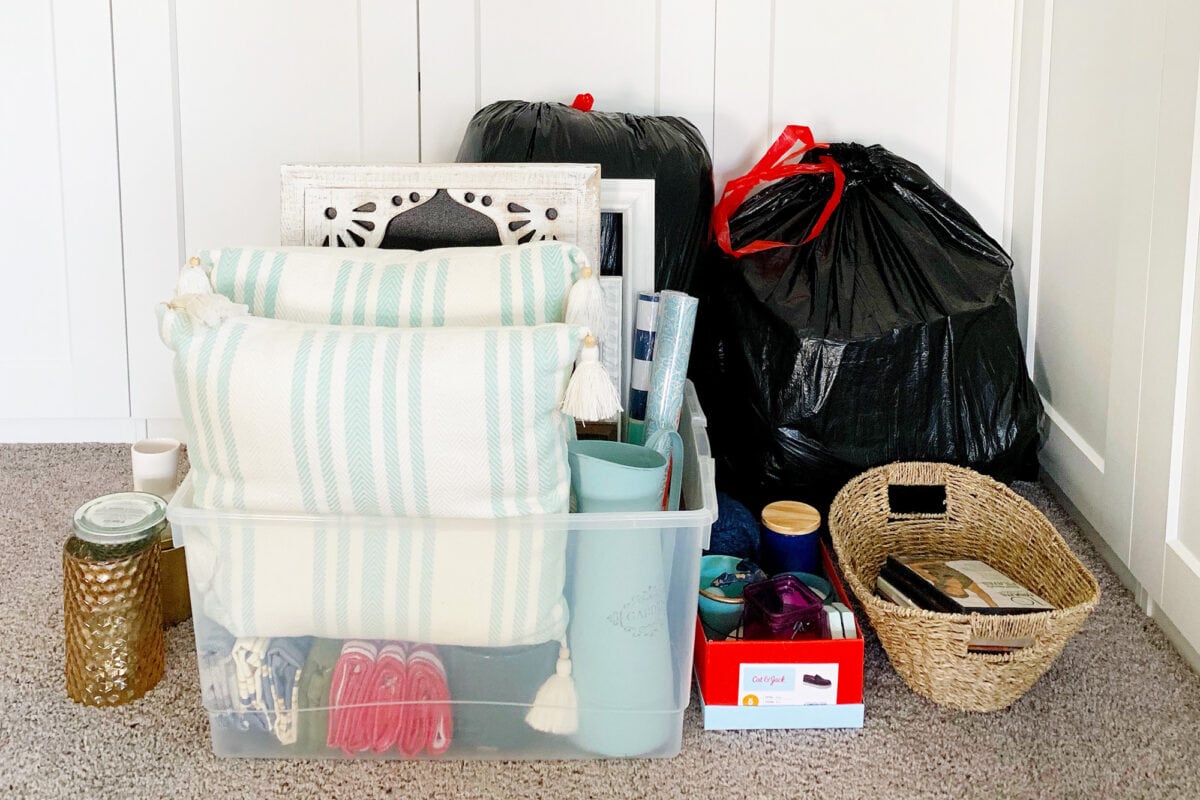
The decluttering weekend method works best for people who don’t have an enormous amount of clutter, are not extremely sentimental, and have both the physical and mental energy to work for several hours a day for a few days in a row.
You can learn more about this method in our Declutter Your House in a Weekend guide.
The Tiny Tidy Method of Decluttering
Other personalities may find themselves frustrated, bored, or overwhelmed at the thought of trying to take on the decluttering of their entire home in such a short stint. If this is you, the Tiny Tidy Method may be a better choice for your decluttering plan.
With the Tiny Tidy Method, you commit to working on one small decluttering task to completion each day (about 10-15 minutes). For example, one day you may tackle the drawer in your bathroom vanity. The next day you might declutter the cabinet in that same vanity. After that, you may move to decluttering the tops that are hanging in your closet, followed by the bottoms the next day, and so on.

While this doesn’t seem like much, these small tasks can really add up over time. And perhaps more importantly, the Tiny Tidy Method gets people into the habit of decluttering, making it feel less like work.
If you get easily overwhelmed by decluttering, don’t have big chunks of time available for longer decluttering sessions, or prefer to use the margins of your day to create small wins, the Tiny Tidy Method could be a good fit for you.
Grab our free printable list of 350+ categories you can declutter in 15 minutes or less to get started with the Tiny Tidy Method!
Declutter One Room Per Month
Another decluttering plan you could follow is the “one room per month” strategy. Breaking down the room into small zones, you work on one zone at a time, scheduling decluttering sessions throughout the month so you can hit every zone in a single room. Then the next month, work on decluttering a different room.

The one room per month strategy is great for people who like to have a set beginning and end point to a project and prefer to work in smaller but intentional increments to make progress on their space.
Our free printable decluttering calendars can help give some ideas and direction if the one room per month strategy sounds good to you.
Choose Your Own Decluttering Adventure
These are just a few examples of ways to plan out our decluttering project to create some structure and deadlines. You can feel free to break down the project in whatever way makes sense for you!
Creating structure around our project helps to eliminate decisions so we know exactly when and what we are going to be decluttering next.

Creating a decluttering plan also helps us break down the project into smaller parts so it feels less overwhelming. “I need to declutter my silverware drawer today” feels a lot more manageable than “I need to declutter my entire messy house and it’s so overwhelming that I don’t know where to start.”
At the end of the day, you can declutter your house in a weekend or take a full year to complete the project, but having a plan in place allows you to track your progress, see the finish line ahead, and continue to move forward rather than helplessly giving up. Use our free printable calendars to create your own custom decluttering plan.
Where to Start Decluttering
I recommend starting your decluttering with an area of your house that will give you a quick win. This could be tackling a small area like your nightstand or your bathroom vanity cabinet or even a single kitchen drawer.
When we get a quick win, we feel encouraged and motivated to continue, and we’ll be more likely to stick with our decluttering plan.
Prepare bags/boxes for discarded items.
Whatever decluttering plan you choose, take the time to make space for items you want to discard before you begin your actual decluttering.

I like to label garbage bags or cardboard boxes with “trash,” “recycle,” “donate,” and “sell” so I can easily sort the items I’m ready to discard.
Have a Plan for Where You Will Discard Unwanted Items
Do you know where you will donate or sell your unwanted items? Determining the details of where you will discard your stuff before you begin decluttering can be a big help as you sort.
For example, I do a big declutter every year before our church’s garage sale and divide up my donate items by the categories I know they’ll be using at the sale. This makes it easier for the church workers to organize and price my items once I’ve dropped them off.
If you could use some help figuring out where to discard your items, this big list from Jessica at The Organized Mama is really helpful.
2. Methodically declutter each space with the ORDER Method.
Now that we have our decluttering plan, we know where we want to start, and we’ve prepped our discard bags or boxes, we’re ready to get started on our decluttering!
I like to use the acronym ORDER to remind me how to move through each step of the decluttering process:
- Out with the trash.
- Rearrange so like items are together.
- Decide what to keep.
- Eliminate unwanted items.
- Return “keep” items to their proper home.
Let’s break down each step of that process…
Out with the trash.
A quick and easy way to start decluttering any space is to remove the trash. Getting rid of trash is typically an easy decision because we’re not attached to it and we can’t use the items that are broken or destroyed anyway.
Getting rid of the trash helps us clear some extra room to work on the rest of our decluttering project and can instantly make the space start to feel tidier.

(Our garage was a total disaster, but after just getting rid of the trash and moving around a few items, we could already park one of our cars in it!)
Rearrange so like items are together.
After we’ve made the easy decisions by getting rid of trash, we can rearrange our items into groupings that make sense.
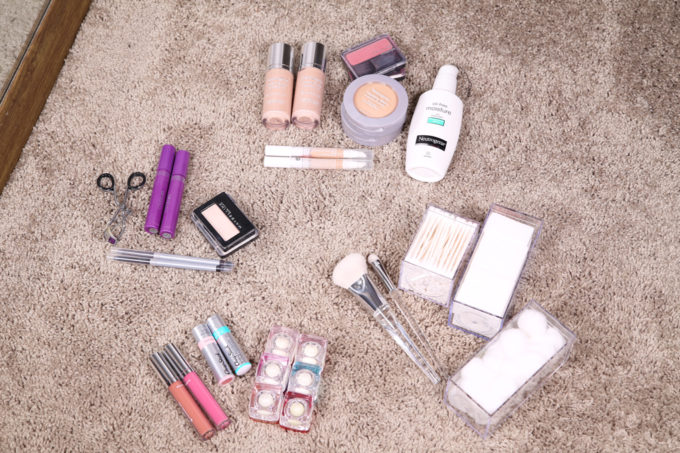
For example, when I declutter my makeup, I put all of the eye makeup together, the lipstick and glosses together, the skincare items together, etc.
This gives us a clear picture of what we have in our space. It also allows us to see if we have multiples of an item so we can make an educated decision about what to keep and what to discard.
And speaking of which…
Decide what to keep.
In Marie Kondo’s book, The Life Changing Magic of Tidying Up, she recommends deciding what to keep rather than deciding what to discard. It’s a small but important distinction.
By choosing what to keep, we are deciding what matters enough to take up space in our home and letting go of the rest. Some questions I like to ask myself when I’m deciding what to keep are…
Is it necessary to keep this item in my home and do I use this item regularly?
Do I love this item or does it make me happy when I use it?
Do I have the space for this item in my home?
If I can answer “yes” to all three of these questions, I know my item is a keeper!
If I can only say “yes” to one or two, I consider whether I have another item that could do the same job or if my life would be just as joyful without it before deciding whether or not to keep it.
And if I can’t answer “yes” to any of these three questions, the item almost never stays on my “keep” list!

“But what if I need it someday?”
This is the question that can paralyze us into inaction while we are decluttering! We have no way of knowing every single situation the future may hold. But the chances of us being able to use ONLY that exact item are pretty slim (especially if we haven’t used it in a while)!
something to think about
If we discard an item and then find ourselves in a situation where we would typically use it in the future, it is likely that…
- We have another item that we could use instead. (If I decide to get rid of my blue cardigan sweater, for example, I could probably wear my denim jacket as a replacement for most outfits.)
- We could borrow the item from someone else. (Ditched the fondue pot but then suddenly started craving chocolate fondue? A friend likely has a fondue pot that we could use for an evening!)
- If worse comes to worse, we could always re-buy the item if we find ourselves needing it over and over again in the future. (But if we haven’t used it in a while at this point, this scenario is very unlikely!)
Rather than focusing on every unlikely scenario in which you would use that item that you haven’t pulled out of its drawer in years, think about how nice it will be to have the extra space freed up for items you truly love and use often!
Discarding the items we don’t love/need makes finding and using the items we do love so much easier.
Eliminate unwanted items, moving them to the appropriate discard bag/box.
After we’ve selected our “keepers,” we can move the remaining items to our “trash,” “recycle,” “donate,” and “sell” bags/boxes so we can discard them after we’ve finished our decluttering session. Since you’ve already decided where you will donate/sell your items, it should be a pretty quick process to get rid of them!
How do I decide what to donate and what to sell?
Our goal with our “discard” items is to get them out of our possession as quickly as possible. Otherwise, they’ll just become another annoying source of clutter!
For this reason, I typically donate almost everything. If I happen to have an item that is worth a decent amount of money, I may take the time to sell it. Otherwise, selling low priced items isn’t usually worth the hassle.
This is totally a personal decision. If you don’t mind spending the time it takes to photograph and list items and communicate with buyers, have at it! But if items aren’t selling quickly, consider donating instead so you can close the loop on your decluttering project.
Return “keep” items to their proper home.
With the discard items removed from the equation, we can now put back our “keepers,” leaving the like items grouped together so we can find them easily.
During this step of the process, you can choose to do as much organizing as you’d like. If dividing up a drawer with small bins to keep everything in its place would be helpful, feel free to take the time to do that.

If adding more organization steps into the mix feels overwhelming, congratulate yourself on completing your decluttering and save the other steps for another time.
Room-by-Room Decluttering Hot Spots
The ORDER Method is effective when followed consistently in any space in your house, big or small. If you aren’t looking to declutter every space but still want to lessen your clutter, here are some key areas in each room you could focus on to make a big difference in the space.
How to Declutter Your Home- Entry
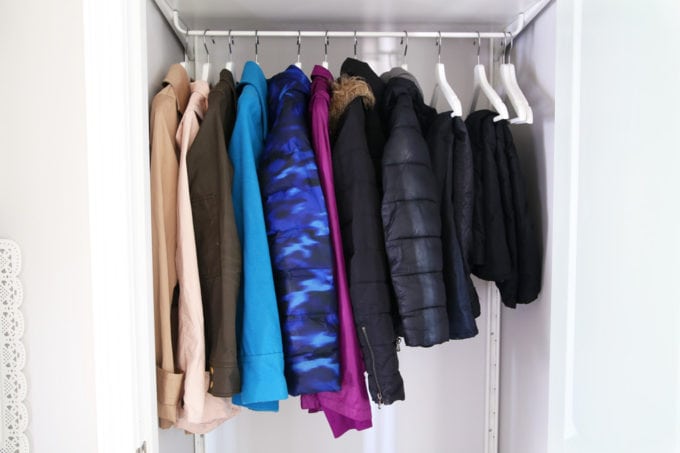
- Coats and outerwear you no longer love/use often. It’s easy to forget about seasonal items we own because we’re not pulling them out all year long! If you haven’t worn that jacket or those gloves in a few seasons, consider donating them to someone who could get good use out of them.
- Worn out/ill-fitting shoes and boots. With kids in the house, it’s easy to accumulate shoes and boots that no longer fit. It’s easy to get those out of the way to make room for the shoes that they actually wear.
- Paper clutter. We often set down the mail or kids’ school paperwork right when we get in the door, causing messy piles. Many times, we don’t need that paperwork and can send it straight to the recycling bin!
Kitchen

- Expired food. Whether in the refrigerator or in the pantry, expired food needs to go! Check labels, remove anything that’s bad, and enjoy all of the extra space!
- Storage containers that are broken or missing lids. Why is it so tempting to hang on to containers when we don’t have all of their pieces? Match up containers with lids and discard anything that is no longer usable.
- Glasses, mugs, and water bottles you never use. It’s easy to accumulate lots of drinkware! Free up space in your cabinets by keeping only the pieces you need/reach for often.
Living Room

- DVDs and video games. I held onto our DVDs for a long time before I realized that we didn’t even own a DVD player anymore! And most video games come in downloadable versions now too. Take a few minutes to get rid of any discs you no longer watch/play.
- Paper, writing utensils, and miscellaneous items in the drawers of the coffee table and side tables. Living room drawers are magnets for clutter. Whenever I clean mine out, I often end up with empty drawers because the items can either be tossed or relocated to their proper homes!
- Books and magazines. Most of us have more of these items than we will ever read. Consider donating the ones you don’t need and clearing some space on your shelves.
How to Declutter Your Home- Dining Room

- Table linens you no longer use. Ya know those table cloths from your wedding registry that don’t even fit any of the tables you own anymore? It’s probably time to get rid of those! 🙂
- Unneeded serving pieces. We sometimes end up with “fancy” serving pieces that we don’t actually use in real life. Free up some space by donating the ones that you don’t need.
- Accessories like napkin rings, candlesticks, and trivets. We often receive these items as gifts, and while we can be grateful for the sentiment behind the gifts, we don’t need to keep them if we never use them.
Bedrooms
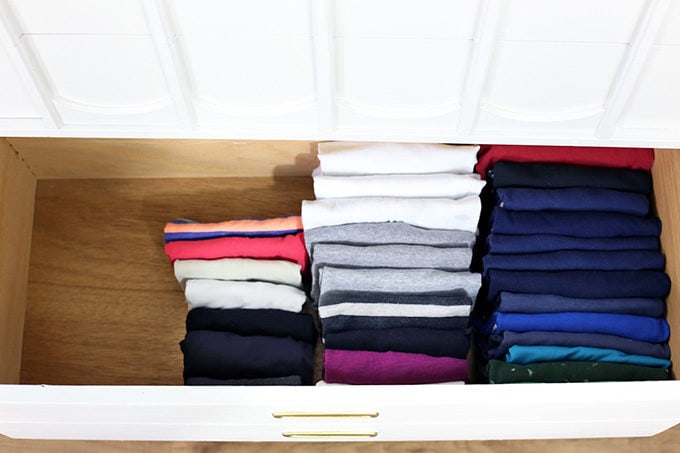
- Tops. If we’re going to accumulate excess in one category of our clothing, it is typically tops. Go through and eliminate any you no longer love or wear often. (Or if you tend to collect a different category of clothing, declutter that one instead!)
- Jewelry and accessories. We often accumulate new jewelry and accessories but never get rid of the old stuff. Take the time to narrow this category to only the items you truly love.
- Nightstand drawers. It’s so easy to throw items in our nightstand drawers and forget about them. Take a few minutes to clear them out, and enjoy all the free space you gain!
Bathrooms

- Old toiletries and makeup. We all probably have some tubes and bottles of goop that are expired. Clear them out to tidy up your bathroom vanity!
- Old towels and washcloths. I hung onto my towels from college for way too long! Animal shelters are often looking for donations of these items, so you can free up space and help cute pets at the same time!
- Hair tools and accessories that you don’t use. The curling iron that didn’t quite work well for your hair. Those headbands you’ve had since high school. The accessories for your hair dryer that you never use. Say goodbye to the items that are no longer serving a purpose for you!
How to Declutter Your Home- Laundry Room
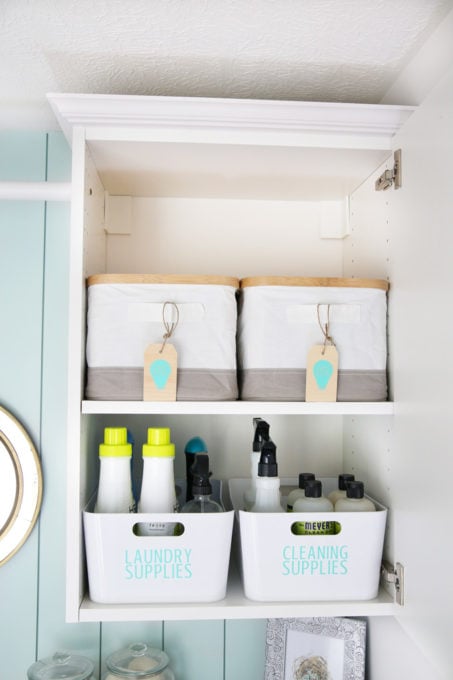
- Old or expired cleaning products. Cleaning products have a way of lurking in our cabinets for years. Get rid of the ones that aren’t being put to use in your home.
- Single socks or other non-wearable clothing items. If you haven’t found the sock’s match by now, it’s probably gone for good!
- Extra sheets and linens. Do we really need 5 sets of sheets for each bed? Probably not!
Home Office

- Old, unneeded paperwork. We likely have a ton of paperwork we can recycle right now! Manuals for appliances and electronics can be found online, as can most financial statements. We likely don’t need decades-old records or paperwork from cars and other items we no longer own. It will feel so freeing to clear all of that stuff out!
- Extra office supplies. I LOVE office supplies, but even I know that they accumulate easily and cause clutter! Consider donating extras to schools or students in your area who could use them.
- Miscellaneous craft supplies or items for other hobbies. Remember when you got into that hobby for about a week, bought all the gear, and then got sick of it? Time to get rid of those items to make room for the things you actually use and enjoy!
Playroom

- Toys children have outgrown. I try to do a sweep of our playroom at least every six months to get rid of the toys our kids aren’t using anymore!
- Games that are missing pieces or are no longer played. If that board game isn’t being played, maybe there is someone else who would enjoy it instead!
- Any toy items that are broken or no longer usable. Pretty much any toy that comes in a Happy Meal can be put in the “no longer usable” category.
How to Declutter Your Home- Garage

- Broken or unused lawn care items. That fun new gadget that didn’t actually work very well? Time to call it and say goodbye!
- Sports/activity equipment that is no longer enjoyed. Crushed beach buckets. Deflated soccer balls. Broken badminton birdies. All of those can go!
- Junk that you know needs to go but put in the garage to delay making a decision about it. Yep. I know you have it. And no, I don’t have a camera on your house. 😉
Basement

- Holiday decor that you no longer use. Maybe it was your style years ago but isn’t anymore. That’s okay! Say goodbye and enjoy the decor that fits your aesthetic right now!
- Old paint or other DIY items. You don’t need that paint color you kept from three houses ago, I promise!
- Old papers, toys, trophies, and miscellaneous items from childhood. If items are truly special and meaningful to you, you definitely don’t have to get rid of them! But if your mom handed you a few bins of your old stuff that you don’t care about and you just stuck them in the basement and never looked at them again, it’s probably safe to get rid of them.
3. Maintain your decluttered spaces with key decluttering habits.
You’ve done the hard work of decluttering your spaces– yay! It would be great if we could just freeze everything in place at this point and not have to worry about decluttering ever again. But the reality is that more items will come into our home. Our lives, routines, needs, and hobbies change, and the stuff we keep in our home will need to change right along with it.
To avoid “clutter creep” and ending up back in the position of living in a very cluttered home, there are a few key habits we can rely on to maintain our clutter-free spaces.
Be choosy about what comes into your home.
Now that we’ve decluttered, it can be tempting to see all of our newly empty space and think, “Ooh, I can fill it up with more fun stuff!” But that is a really quick way to end up living amongst clutter again!
Instead, before we buy anything new, we should ask ourselves whether we want to dedicate an amount of space in our home to that item. Do we already own another item that could serve the same function as the thing we are thinking about buying? Do we truly love or need the new item?
It’s okay to say “yes!” to some of these questions! It’s not realistic to never buy another item or splurge on something fun again. What we’re trying to avoid are those impulse purchases of so-so stuff that we don’t really even want or need.
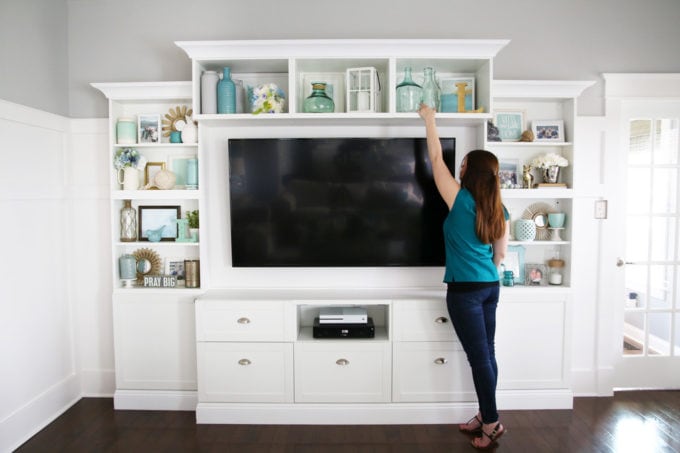
Adopt the “one in, one out” rule.
Whenever we do decide to bring something new into our home, we should examine that category and see if there is another item that we would be willing to part with.
For example, if I get a new dress, I can look through my current dress collection and weed out a different dress that I no longer love or wear often.
It helps to have a designated spot for “donate” items so you can weed out unwanted articles quickly and easily. (I keep a donate bin in the back of my closet. When it fills up, I empty it out and make a trip to the donation center!)

(You can spot my donation bin in the back corner of my closet!)
Hold a decluttering weekend once or twice per year.
After I’ve gone through and done a major declutter of my whole house, I’ve found it’s helpful to do a maintenance “decluttering weekend” once or twice per year.
During this weekend, I work my way through each room of the house and remove anything we no longer love or use often. If I am consistent about following through with this decluttering weekend each year, it’s typically pretty easy to pull off because our house stays fairly uncluttered.
How to Declutter Your Home: Frequently Asked Questions
In theory, decluttering sounds pretty simple. We’re just going through our stuff and weeding out anything we no longer love or use often.
But in practice, decluttering can feel a little trickier. There are several questions I get anytime I’m talking to people about decluttering, so I wanted to make sure I touched on those things before we wrap up our decluttering extravaganza!
How do I declutter sentimental items?
Two useful strategies for decluttering sentimental items are creating a set amount of space for mementos and choosing one item to represent a collection.
We can have a lot of feelings and memories attached to our stuff. I am never going to tell you that you need to get rid of something that means a lot to you. You should keep items that have a special meaning.
But I will say that most of us hold onto way too much in the “sentimental” category, and it actually dilutes the importance of the items that truly are special.
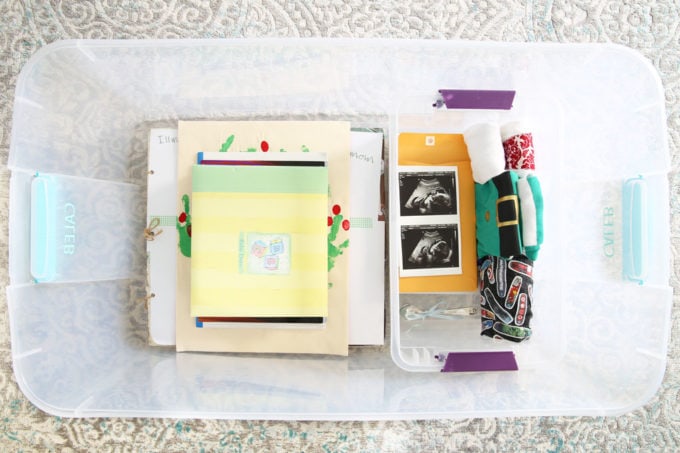
If we have hundreds of “special” items, for example, it’s impossible to adequately think about, appreciate, take time for, and display all of those things. They all end up shoved in a box that we never look through because there are just too many to deal with.
But if we have a smaller number of “special” items– let’s say 5, for example– we can create a special display for them in our home. We can look at them and appreciate them often. And we can reflect on the memories they invoke. In this case, less is more.
[I’m not saying that 5 is the “correct” number of special items to have. You can have more or less than that. It all depends on how many you think you can adequately make space for and appreciate.]
Here are a few ways to help us cut down on the number of sentimental items we own so we can focus on the few things that are truly important…
Create a set amount of space for sentimental items.
In our house, each family member has one large tub available for sentimental items they want to keep. When the tub starts to get full, we look through it and see if there is anything we may be ready to part with.

If you are a highly sentimental person, you may decide that two or three tubs per person is the right amount for you, and that’s fine. The important thing is to set a limit and stick to it.
Choose one item to represent a collection.
Often, we will accumulate a collection of a certain type of item. And if the collection as a whole is meaningful to you and important to keep together, that’s fine.
But sometimes owning a collection can dilute the meaningfulness of some of the individual pieces of the collection.
For example, my grandmother gifted me angels throughout my life before she passed away. They were special because she gave them to me, but most of them didn’t match my decor style, so they stayed wrapped in a box in the basement, and I rarely thought about them.
Eventually, I ended up selecting my favorite angel to represent the collection and my memories with my grandmother, and I let the rest go. Now that angel sits in my office where I see it all the time and appreciate the memories it holds.

In this case, choosing one item to represent the entire collection was much more effective and it reduced the clutter in my home.
Learn more about decluttering sentimental items here.
How do I declutter when I have trouble letting go of things?
If you have trouble letting go of things, one way to make it easier is to have someone work on your decluttering project with you.
Having a second set of hands can make the job feel less overwhelming, but there is an even greater benefit as well. Another person can listen to your stories about the items that you’re decluttering. This can help you process them, appreciate the purpose they served during the time you owned them, and then let them go.
Sometimes just expressing the feelings or sentiments we have about an item is enough to let us say goodbye.
Learn more about decluttering when you have trouble letting go of things in this post.
How do I declutter when I feel overwhelmed?
When we’re feeling overwhelmed by our decluttering project, one of the most effective things we can do is break it down into smaller pieces.
Instead of the end goal being, “I need to declutter my entire house,” try the Tiny Tidy Method or the one room per month strategy mentioned previously in this post.

When our goal on a given day becomes “declutter one drawer” or “declutter one category of clothing,” that feels a lot more manageable than “declutter the whole kitchen” or “empty out your entire closet.”
If you need to break it down even further than that and make it your goal to just declutter one item per day for a while until you can manage a little more, that works too! The key is to make the process feel manageable to you.
Learn more about decluttering when you feel overwhelmed in this post.
How do I get my family on board with the decluttering process?
The most effective way to get the family on board with decluttering and organizing is to create systems they can easily follow. Complicated systems don’t last long and are a huge hurdle for getting others to help.
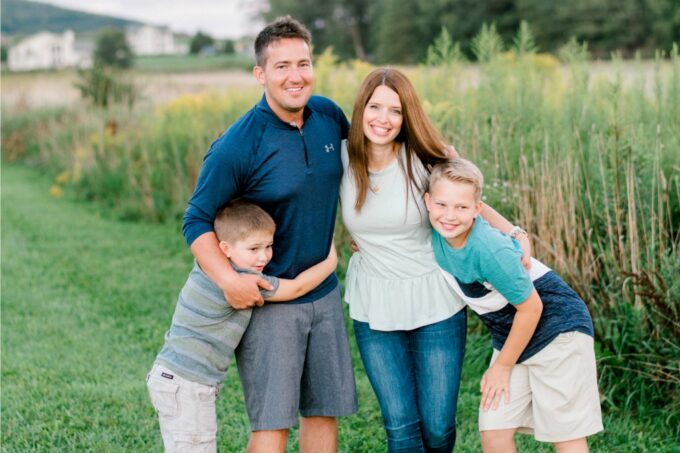
When getting the family on board with decluttering, it’s also important that we are willing to lead by example. If decluttering is more important to us than to our family members, we will need to lead the charge and play a big role in making it happen. This doesn’t mean we need to do everything ourselves though.
Coming up with a list of decluttering tasks and talking to family members about which ones they would most like to help with can help them have some choice in and ownership of the process.
Allowing your family members to catch the vision for how great it feels to live in an uncluttered space by helping them to declutter a space in the house that is meaningful to them can also be a powerful tool for getting others on board.
How to Declutter Your Home: Final Thoughts
I hope this post gave you some helpful ideas that you can apply as you work to declutter your home. Living in a clutter-free house can lower our stress levels and allows us to enjoy the space where we live and that is a pretty exciting result!
Decluttering doesn’t have to be this big, daunting task. In fact, if we keep our end goal in mind, it can be fun to be able to make progress one small step at a time!
More Inspiration for How to Declutter Your Home
Want to save this post to revisit later? Be sure to pin the image below so you can find it easily!

What space are you going to work on decluttering first? Let me know in the comments below!
Thanks so much for following along! Have a wonderful day!


